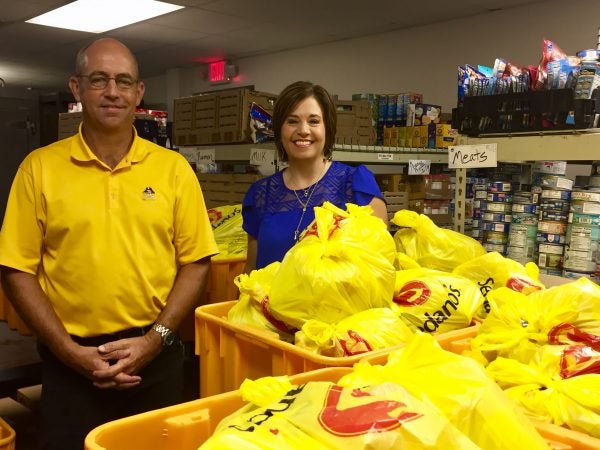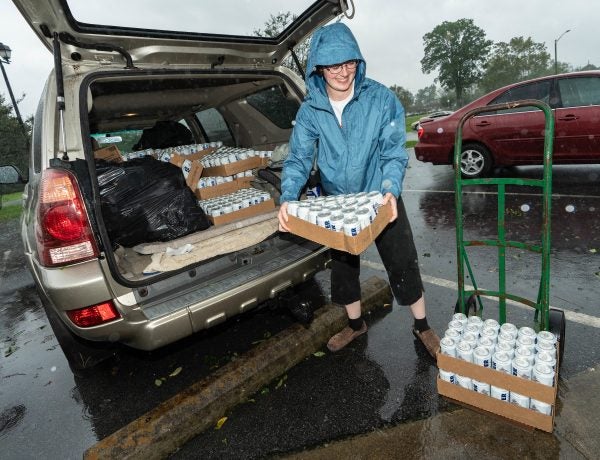FLORENCE ANNIVERSARY
One year after Hurricane Florence, rural NC is still struggling. ECU is trying to help.
A year after Hurricane Florence tore through the small community of Pollocksville, the post office remains closed. The squat red brick building, along with the town hall on the edge of the Trent River, was one of many businesses flooded when the river breached its banks last September. Instead, a mobile van operated by the U.S. Postal Service is parked further into town, a safe distance away. In some of the low-lying places, it looks like the hurricane hit yesterday. Windows are boarded up and debris sits on porches, long after the cleaning crews have come and gone.
Hurricane Florence hit North Carolina on Sept. 14, 2018 as a Category 1 storm. Though its winds weakened, Florence dumped record rainfall across North Carolina, causing massive flooding, hundreds of road closures and 39 deaths in the state. The storm caused $24 billion in damages, including an estimated $13-18 billion in uninsured property damage, according to the National Oceanic and Atmospheric Administration.
Immediately after Florence, East Carolina University volunteers recorded thousands of hours of recovery support, collecting more than 80,000 pounds of nonperishable foods and goods and $370,131 in financial and in-kind donations. The university assisted 65 small businesses during the recovery process in nine eastern North Carolina counties, totaling 150 hours of service.
Months later, ECU researchers remain focused on Florence, studying mental health, coastal erosion and farmland impacts in the hardest hit areas. ECU alumni are staying involved as well.

John Taylor and Mary Ann LeRay tour the food storage area at The Filling Station in Pollocksville. (Contributed photo)
On a recent Tuesday in Pollocksville, about a dozen people stood in line getting corn flakes, bags of potatoes, loaves of bread and dish soap at The Filling Station, a former gas station-turned food pantry and resource center. John Taylor, volunteer treasurer for The Filling Station and ’89 alumnus, said the town is getting back to normal, but places like this help keep people going.
“It’s very satisfying and rewarding to see the work being done here. It’s a great community and a great cause,” he said.
Started by Pollocksville Presbyterian Church, The Filling Station has been heavily involved and instrumental with helping residents in and around Jones County after Florence. It opened one week before the storm hit and quickly became the center of relief efforts in the area.
From September to December 2018, it served more than 10,000 people, according to executive director Mary Ann LeRay. Although it stopped disaster relief in January, 4,500 people have been served since then, she said.
“There are still many people in need who are still feeling the storm’s effects. Lots of people in town are still waiting on FEMA support,” LeRay said.
Across Jones County, 111 homeowners have sought expedited buyouts because of Florence, more than any other North Carolina county, according to a joint state-federal notice.
Dr. Heather Littleton, professor of psychology at ECU, has been studying how people are adjusting and coping with long-term storm trauma. Her study, funded by a nearly $200,000 RAPID grant from the National Science Foundation, started five months after Florence.

As part of hurricane preparation, then second-year medical student Holly Pittard unloaded water at the Walter B. Jones Center in Pitt County as part of hurricane preparation. (Photo by Cliff Hollis)
“Immediately after a natural disaster, people are working together and helping each other, but that’s not the end of it. Eventually the shelters close down, the resource centers go away, and deadlines for getting funding from the government pass,” Littleton said. “Just going and cleaning up, that’s step one. We need to think about how we bring mental health help to people. That’s an unaddressed need.”
Of the 260 individuals surveyed from Robeson, Bladen, Columbus, and Scotland counties, 44% were displaced from their home for more than two weeks and 67% developed a new or worsened mental health condition. Further, 26% of participants reported that their children developed a new or worsened mental health condition, Littleton said.
Littleton also noticed that the start of hurricane season was a trigger for those Florence affected.
“Heavy rains are distressing. It’s well known in the trauma field that people can have anniversary reactions,” she said. Her study is ongoing.
The Atlantic hurricane season started on June 1 and runs through Nov. 30. NOAA announced in early August that conditions are favorable for “above normal” hurricane activity in the Atlantic Ocean this year. On Sept. 6, Hurricane Dorian, a Category 1 storm, made landfall on North Carolina’s Outer Banks and caused flooding in some areas.
Dr. Loni Crumb, a licensed counselor and assistant professor in the College of Education, has an ongoing qualitative study about rural counselors’ experiences with disaster mental health. She said rural areas are often the most underserved when it comes to mental health.
“Even a year later, there’s an ongoing need for mental and psychological help,” Crumb said. Post-traumatic stress, relocation stress and relational stress are all factors to watch with natural disasters, especially in the school systems, she said. Counselors can prepare for the upcoming hurricane season by partnering with outside organizations — including faith-based organizations like churches — to stretch resources, and they need to understand that the counselors themselves are vulnerable to trauma, Crumb said.

Items damaged by Hurricane Florence lined the streets in Pollocksville shortly after Hurricane Florence. (Photo courtesy of The Filling Station)
“Having a plan can help reduce anxiety. Being proactive, knowing what your resources are and who to contact beforehand can prevent panic mode if and when the next storm hits,” Crumb said.
ECU is helping the region prepare for the next hurricane in other ways, too.
Money from ECU’s Hurricane Relief Fund was used to host a disaster-themed Make-A-Thon, where students developed new ideas and innovations to problems that plague communities after natural disasters. In addition, the university hosted a hurricane conference in May and a Disaster Recovery Contracting Summit in August.
The university is better prepared to react and help during future natural disasters, said Sharon Paynter, assistant vice chancellor for community engagement and research and leader of ECU’s hurricane relief efforts after Florence.
“Last year, we were essentially driving the road while we were paving it,” Paynter said. “I think we learned a lot about the systems that we have in place and how we can best respond.”
Back in Pollocksville, Filling Station director LeRay is also optimistic.
“This storm has made us more resilient. This has truly been a place of healing for people,” she said of the food pantry. Filling Station volunteers even recently went to repaint the walls of the post office. It should be open in a matter of weeks.
RELATED STORIES:
